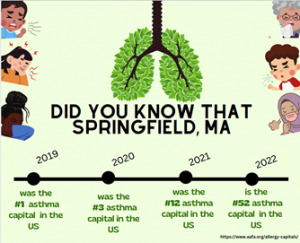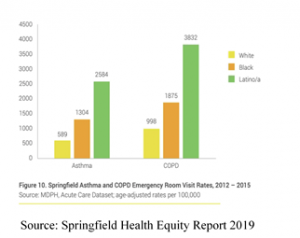 In 2019, Springfield was the number 1 asthma capital in the United States. The impact of high asthma rates, particularly among children, prevents individuals from living a healthy and active lifestyle and contributes to missed school and work days. However, the increased rates of asthma are not distributed equally throughout different neighborhoods; Latinx and African American communities are bearing the brunt of poor asthma outcomes. Latinos in Springfield and neighboring city Holyoke are four times more likely to end up in the emergency room compared to Caucasians, while African Americans are two times as likely. A combination of factors contributes to the higher asthma rates, such as increased air pollution, living near highways, dust mites, secondhand smoke, and obesity. While there is not one simple solution to addressing racial disparities in asthma rates and exacerbations, focusing on improving the living, working, and playing environment of community members is one important component.
In 2019, Springfield was the number 1 asthma capital in the United States. The impact of high asthma rates, particularly among children, prevents individuals from living a healthy and active lifestyle and contributes to missed school and work days. However, the increased rates of asthma are not distributed equally throughout different neighborhoods; Latinx and African American communities are bearing the brunt of poor asthma outcomes. Latinos in Springfield and neighboring city Holyoke are four times more likely to end up in the emergency room compared to Caucasians, while African Americans are two times as likely. A combination of factors contributes to the higher asthma rates, such as increased air pollution, living near highways, dust mites, secondhand smoke, and obesity. While there is not one simple solution to addressing racial disparities in asthma rates and exacerbations, focusing on improving the living, working, and playing environment of community members is one important component.
Our interprofessional healthcare team, made up of three UMass Chan medical students and one Bay Path University physician assistant student, was particularly interested in examining the intersection between human health, socioeconomic factors, and urban tree coverage in different Springfield neighborhoods. Urban tree planting has numerous physical, mental, environmental, and community benefits. Trees play an important role in improving air and water quality, which can help to reduce pediatric asthma emergency department (ED) isits and hospitalizations. In addition, people in urban areas have better overall health and a lower risk of developing psychological distress if they have trees within a walkable distance from their homes. Trees are also essential to lowering energy use, reducing air temperatures, enhancing carbon storage, and mitigating disaster risk. At the community level, urban tree planting also lowers crime rates, improves school performance, and enhances social cohesion.
We worked closely with Dave Bloniarz at ReGreen Springfield, an organization that “collaborates with businesses, community organizations, educational partners and government agencies to promote the reforestation of Springfield, improve growing conditions for trees and engage new allies in tree care and monitoring, education and citizen science”. Through Dave and ReGreen Springfield, we learned about the Greening the Gateways Cities Program (GGCP), which is a statewide initiative aimed at reducing heating and cooling energy by increasing tree coverage in urban areas. This program allows residents in the Upper Hill, Old Hill, and McKnight neighborhoods in Springfield to request a free tree to be planted on their property. The GGCP makes it easy to obtain a free tree. Residents can dial 3-1-1 to request a free visit with a city forester and then typically within a year have a tree planted in their yard. However, there have been relatively minimal requests from residents in the three target neighborhoods for a free tree planting.
promote the reforestation of Springfield, improve growing conditions for trees and engage new allies in tree care and monitoring, education and citizen science”. Through Dave and ReGreen Springfield, we learned about the Greening the Gateways Cities Program (GGCP), which is a statewide initiative aimed at reducing heating and cooling energy by increasing tree coverage in urban areas. This program allows residents in the Upper Hill, Old Hill, and McKnight neighborhoods in Springfield to request a free tree to be planted on their property. The GGCP makes it easy to obtain a free tree. Residents can dial 3-1-1 to request a free visit with a city forester and then typically within a year have a tree planted in their yard. However, there have been relatively minimal requests from residents in the three target neighborhoods for a free tree planting.
To raise awareness about the benefits of trees and promote engagement with the Greening the Gateway Cities program, we designed two different informational flyers which were translated into both English and Spanish. We distributed the flyers to homes and businesses in the Old Hill neighborhood and to the Dunbar Community Center after school program. We also distributed flyers alongside candy at the Springfield Boys and Girls Club to children and families attending their Halloween Trunk or Treat event. As we distributed flyers within the Old Hill neighborhood, we also spoke with residents about the importance of increasing tree coverage and listened to their perspectives on trees. Additionally, we quantified the environmental savings of individual trees over a 20-year period on streets surrounding the Dunbar Community Center using the online software Treekeeper Springfield and MyTree. We calculated that each tree could provide $1014.00 in savings over the next 20 years. We created tree tags with this information and attached them to trees in the Old Hill neighborhood. The tags included encouragement for residents to call 3-1-1 for a free tree. We’re hoping this multifaceted approach will increase engagement with the GGCP and improve air quality, respiratory illness, and community resilience in the Upper Hill, Old Hill, and McKnight neighborhoods.
A copy of our i-Tree Landscape Analysis report can be found at this link: http://www.regreenspringfield.org/purch
Erica Dean, Medical Student, UMass Chan Medical School
Maximilian Kinne, Medical Student, UMass Chan Medical School
Helen Mizrach, Medical Student, UMass Chan Medical School
Yvonne Thomas, Physician Assistant Student, Bay Path University
 Healthcare Workforce Partnership
Healthcare Workforce Partnership  REB - REGIONAL EMPLOYMENT BOARD OF HAMPDEN COUNTRY, INC.
REB - REGIONAL EMPLOYMENT BOARD OF HAMPDEN COUNTRY, INC.